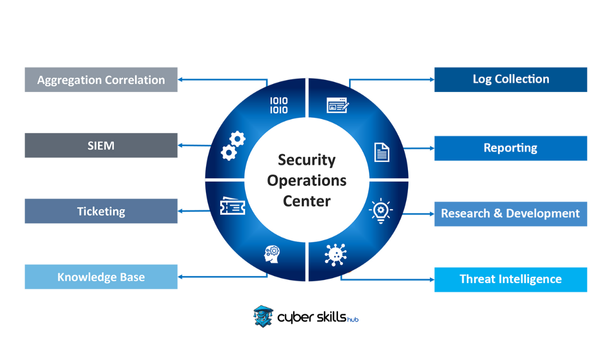Currently Empty: $0.00

How do you ensure results in your cyber security operations? Security Operations Center (SOC) plays a critical role in this context.
SOC activity is a necessity and should be integrated with audit processes and work in harmony with the NOC.
This center provides 24/7 monitoring and response services to ensure that your network is protected against threats.
Definition and Purpose of SOC
SOC is the central unit designed for organizations to be able to defend against cyber security threats.
This unit brings together all the processes and technologies needed to monitor, detect, analyze and respond to security incidents. Its goal is to ensure business continuity by continuously protecting the organization’s assets.
SOC creates an effective defense mechanism by providing ”24/7″ and “360-degree” monitoring.
What is SOC?
SOC (Security Operations Center) is a professional unit established to provide effective defense against cyber threats. This center provides continuous monitoring and analysis services.
Equipped with expert analysts and advanced technologies, the SOC performs critical tasks such as anomaly detection and incident response. They quickly identify and eliminate potential threats by examining past behavior.
With its real-time threat detection and response capabilities, the SOC provides an instant solution against cyber attacks.
Security operation centers protect the digital assets and information technology infrastructure of the institution. In this way, a fast and proactive defense mechanism is created against internal and external threats. In addition, SOCs are constantly updated against new threat vectors, and personnel receive training against new types of threats.
For a deeper understanding of SOC activities, What is Cyber Security Expertise? and the SANS Institute SOC you can check out their pages.

Functions of the SOC
SOC performs various critical functions that will improve the information security effectiveness of an organization.
The most important of these functions is continuous monitoring and detection of anomalous activity. SOC teams continuously observe network traffic, system logs and endpoint behavior, and prepare reports of these observations.
Using this analyzed data, SOC teams quickly identify potential threats and take the necessary preventive measures. This helps the organization to proactively improve its cybersecurity posture.
In addition, the SOC staff incident intervention and forensic analysis he also plays a role in their processes. In the event of a possible cyber attack, they take control of the incident by providing a quick response and try to resolve it without leaving a trace.
Finally, the experts present at the SOC keep their knowledge and skills up-to-date through continuous trainings and simulations.
SOC Components
A Security Operations Center (SOC) usually consists of several key components. These components include human resources, technology and processes. Human resources include cybersecurity experts and analysts working in the SOC.
The technology component consists of various security tools, software and NOC systems. Processes, on the other hand, cover methodologies that regulate the management and response of security incidents.
Hardware and Software
Both hardware and software components are critical for a Security Operations Center (SOC) to function effectively.
- SIEM (Security Information and Event Management) software
- IDS/IPS (Intrusion Detection and Prevention Systems) devices
- Firewalls and VPN devices
- Threat intelligence platforms
- Forensic analysis and incident response tools
These components enhance the SOC’s threat detection, analysis and response capabilities.
In addition, the hardware devices contained in the SOC need regular maintenance and updating.
Software, on the other hand, should be constantly updated against new threats and should work integrated with each other.
For detailed descriptions of SOC technologies and usage examples The Best Cyber Security Tools you can review our article.
Human Resources
Human resources are the cornerstone of SOC.
Cyber security specialists working at SOC carry out the analysis and operations. These specialists should have a wide range of technical know how and strong problem-solving abilities. Usually, they are expected to have cyber security certificates and are ready for up to date threats with continuous training.
Team dynamics between the SOC and the NOC are also of great importance.
The capabilities and areas of expertise of the personnel serving in the SOC should cover a wide range – for example, threat hunting, incident response, forensic informatics. This ensures that the team is able to respond quickly and effectively to all types of cybersecurity breaches.
For an efficient SOC structure, continuous motivation and professional development of human resources should be encouraged. Educational programs, conference participation and internal training programs help to create a team equipped with the most up to date knowledge and techniques against cyber threats. In addition, when considering the 24/7 operation structure of the SOC, shift management and staff welfare should also be taken into account in strategic planning.

SOC Methods
Among the SOC methods, there are two main categories: proactive and reactive approaches. Proactive methods aim to detect threats before they appear, while reactive methods intervene in events that have already occurred.
Proactive methods include threat hunting, continuous security audits and threat intelligence. Reactive methods include steps such as incident response processes, forensic analysis and post-incident assessments. For the successful implementation of these methods, it is critical that SOC teams have both proactive and reactive competencies.
Monitoring and Analysis
Monitoring and analysis, Security Operation Centers (SOC) there are two basic activities that are of critical importance for it. These activities provide information for the detection and management of security incidents.
- Real-time monitoring: Instant detection of security incidents.
- Comprehensive registration reviews: In-depth analysis with log data.
- Anomaly detection: Identification of unusual behavior.
- Integration of threat intelligence: Risk assessment with up to date threat information.
The tools used in this process include technologies such as SIEM (Security Information and Incident Management) systems and Enpoint Detection and Response (EDR) software.
By analyzing the collected data, SOC analysts identify potential threat scenarios and develop appropriate response strategies against these threats.
Threat Intelligence
Threat intelligence enables security operation centers (SOC) to be more proactive and prepared against cyber threats.
SOC teams analyze this information to identify and evaluate potential cyber threats.
Threat intelligence includes the detection of tactics, techniques and procedures (TTPs) of individuals or groups conducting attacks.
This information helps SOC analysts to respond quickly and effectively to the constantly changing threat environment.
Threat intelligence sources usually include information flows from open sources, commercial intelligence services, and the security community. Thus, organizations can compare their own security structures with the current state and future trends of threat environments.
As a result, the effectiveness of the SOC is directly related to the scope and accuracy of threat intelligence. By giving depth to security operations, effective prevention of threats is ensured.
Importance of SOC
Security Operations Center (SOC) is one of the essential elements of an organization’s cyber security strategy. SOC protects organizations’ critical data and systems by constantly monitoring to detect, analyze, intervene and prevent cyber attacks.
SOC strengthens the security posture in organizations and increases the ability to respond quickly and effectively to cyber threats faced by enterprises. Thus, potential losses and the impact of security breaches are minimized.
Company Security
Company security has become one of the most critical priorities for businesses in the modern world. Security Operation Centers (SOC) are the center for ensuring this security.
SOC continuously monitors all digital assets of enterprises and responds instantly to possible threats. These monitoring and intervention processes ensure the operational continuity of the companies. This security provided by SOCs minimizes the risk of data loss while protecting the reputation of enterprises.
In an environment where cyber threats are constantly evolving and becoming more complex, SOCs keep companies’ cyber defense mechanisms up to date. Thanks to advanced threat intelligence and analysis tools, SOCs detect abnormal activities and take the necessary measures.
SOCs not only respond to attacks, but also improve the security policies of organizations. Practical trainings and simulations increase employees cyber security awareness and ensure that they are prepared for possible security breaches.
A robust SOC infrastructure helps companies to be resistant to cyber attacks. It requires cybersecurity experts to be constantly online.
Continuous Improvement
SOCs are subject to a continuous improvement cycle in order to perfect their cybersecurity processes and increase resilience to new threats.
- Collecting Feedback: Feedback is collected in all incident management processes and daily operations.
- Performance Monitoring: Security tools and processes are constantly evaluated by performance monitoring methods.
- Identification of Shortcomings and Strengths: Assessments made by identifying shortcomings and analyzing strengths.
- Updates and Trainings: Regular planning is made for personnel training and updates of security tools.
- Adapting to New Protocols and Policies: Rapid implementation of protocols and policies developed against new threats.This cyclical method both increases the effectiveness of SOCs and allows them to respond faster and more accurately to threats.
Continuous improvement keeps the information up to date and operational capabilities of cyber security personnel at the highest level.
These processes proactively strengthen the overall security posture of the organization.
If you are thinking of becoming a SOC analyst, SOC L1 Training you can specialize in this field by joining the program.
Frequently Asked Questions About the SOC
What does SOC mean?
SOC is often referred to as a “Security Operations Center”. These centers monitor and manage various security incidents in real time to ensure the information security of organizations. SOC teams take proactive measures against potential cyber-attacks using advanced threat intelligence and analysis tools. Thus, security breaches are minimized and loss of reputation of the organization is prevented. SOC teams work 24/7. The basic components of a SOC include SIEM (Security Information and Event Management), IDS/IPS (Intrusion Detection and Prevention Systems) and various security analysis tools. With these components, security incidents are detected and responded to quickly and effectively. The effectiveness of the SOC is directly proportional not only to the technologies used, but also to the knowledge and experience of the team.
What are Siem and SOC?
SIEM and SOC are critical in cyber security. SIEM (Security Information and Event Management) is a solution for collecting, analyzing and managing security events from a central point. SIEM systems collect log and event data from various sources, correlate and detect anomalies. In this way, organizations can quickly respond to potential security threats. SOC (Security Operations Center) is the center where security monitoring and response operations are carried out. The SOC conducts real-time threat monitoring, analysis and response operations using SIEM systems. SOC teams are prepared 24/7 against cyber attacks and respond quickly to incidents. This strengthens the cyber security position of organizations.
What does SOC Analyst mean?
A SOC (Security Operations Center) Analyst is a critical cybersecurity specialist who constantly monitors and protects an organization’s digital assets. SOC analysts use advanced tools and techniques to detect, respond to and prevent security incidents. SOC analysts monitor network traffic, system logs, and user activity. Their goal is to intervene by detecting potential threats at an early stage. In case of detection of a security incident, analysts quickly assess the incident and take the necessary measures.
What does SOC Engineer mean?
A SOC Engineer works in the Security Operations Center (SOC), protecting organizations digital assets against external threats. SOC engineers monitor, detect and respond to security incidents. Their daily workload includes analyzing network traffic and classifying security incidents. SOC engineers are experts in advanced security tools and techniques used in cyber attack detection. They use threat intelligence to proactively secure systems. Other responsibilities include analyzing and reporting security incidents and organizing incident response processes. SOC engineers use automation solutions and software tools to make incident detection and response faster and more efficient. This multidisciplinary role requires continuous learning and keeping abreast of technological developments.







